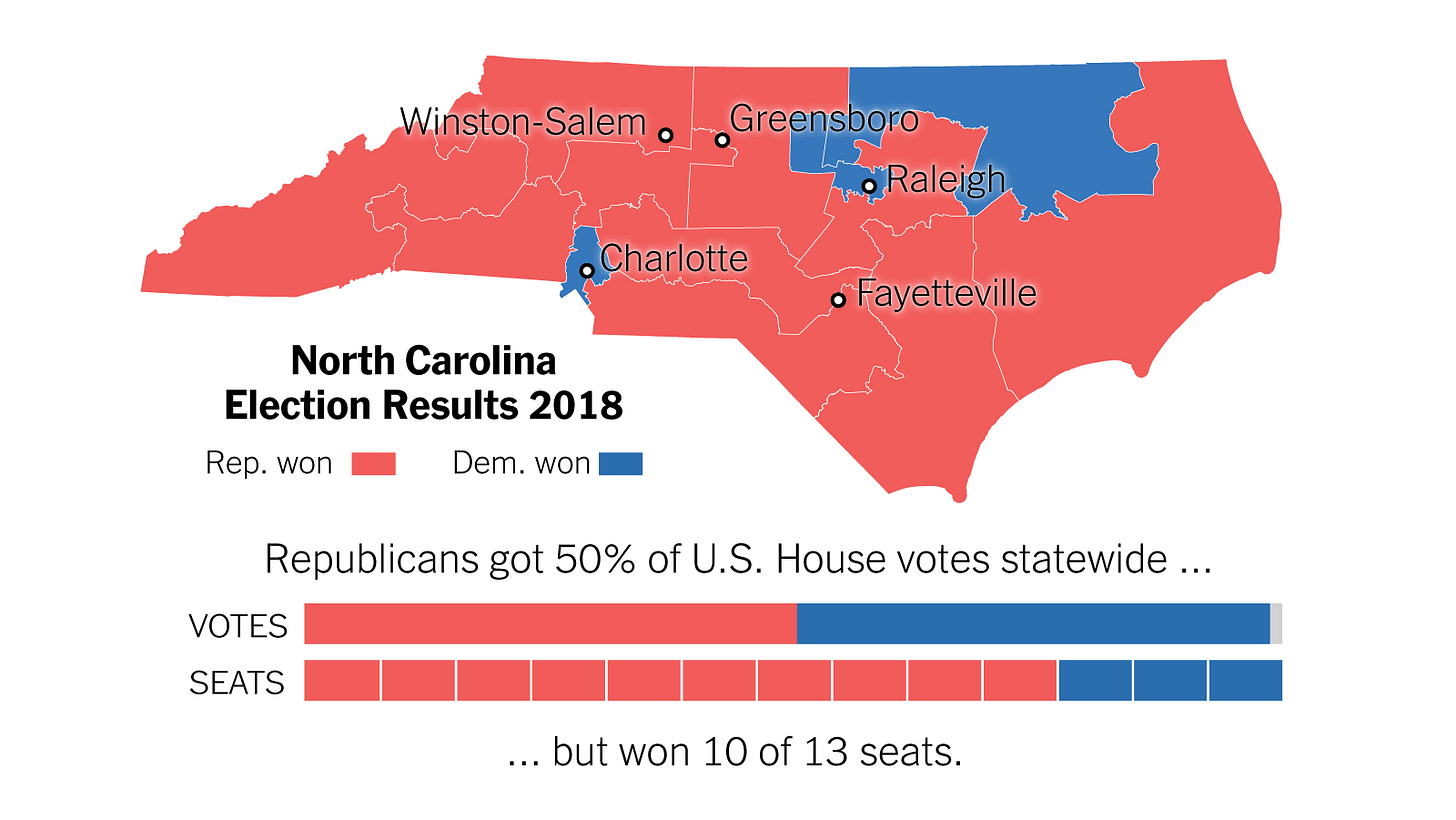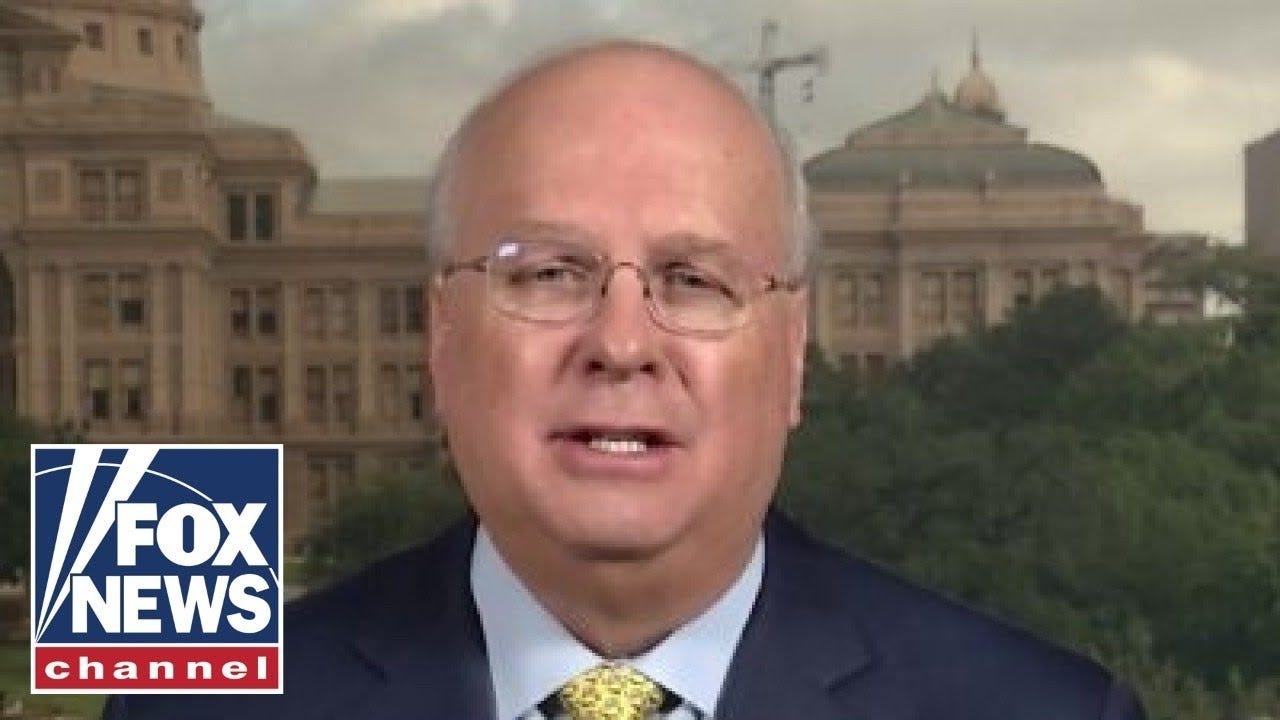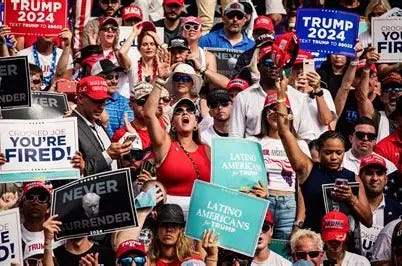How About Dems USE POWER--Stop the GOP's Anti-Democracy Gerrymandering!
🎵 There’s a warning sign on the road ahead. There’s a lot of people saying we’d be better off dead - Neil Young, "Rockin in the Free World"
Cliff’s Note:
Today we have a guest column from contributor Matt Robison! Enjoy and have a good weekend (though we’ll see you tomorrow, of course, with a great David Shuster piece, and I’ll be back on tomorrow or Sunday). But, first, a word FOR our sponsor. You!
Independent Media Just .26/day W/ Paid-Subscription Benefits!
Connect With Us: Weekly AMA w Cliff & David! Comment on all content and DM us
Get Behind The Velvet Rope: Insider stories, behind the scenes video from lives, including bloopers and drafts
Get Recognition: Shout-outs to new paid members during Lives!
Save Democracy: Support our Soundcheck Fund to create an ecosystem of independent-media creators to Save our Democracy
“What’s stronger than a blue wave? Gerrymandered districts”
With Control of Big States Like California, It’s Time To Use Our Leverage To Thwart Authoritarianism
America's two major political parties are about to exchange the next salvos in a decades-long battle where—as is typical of trench warfare—they both stand to lose.
Texas Governor Greg Abbott is under severe pressure from President Donald Trump to restart one of the most craven and self-destructive practices of American politics in the 21st century: predatory gerrymandering. California Governor Gavin Newsom has made clear that, if Abbott goes through with it, he stands ready to retaliate.
If you're thinking "gee, this sounds like a boring, technical issue for government nerds to fuss over," it's not. It's been a poison that's seeped further into our political life than most realize.
Here's what happened. Partisan gerrymandering—drawing legislative and congressional districts to maximize your party's power—goes back literally to the birth of the republic. But for most of the 20th century, state political leanings were so stable that parties kept their maps in place.
Even after Supreme Court rulings in the mid-1960s forced change, the parties settled into a fairly anodyne process, forming districts once every ten years after the new national census with only minor angling for political advantage.
In 2003, then-House Republican Majority Leader Tom DeLay broke the tacit truce. After Texas drew its districts following the 2000 census, he waited for Republicans to gain complete control of Texas government, and then maneuvered an ambush: a sudden redraw that gave Republicans six more congressional seats.
Once DeLay started this new predatory approach—grabbing for power at any opportunity—others followed. Republican-dominated states started to copycat Texas, and Republicans saw an opportunity if they were really willing to push the envelope.
Political strategist Karl Rove crafted a project called REDMAP. It’s goal was simple—to win key state legislative seats all over the country in order to drive an even more aggressive round of congressional redistricting.
It worked: in 2012, Democrats won 1.4 million more votes for the U.S. House than Republicans, but Republicans won the chamber 234-201. In Wisconsin’s legislature, as just one example, Republicans won less than half of the statewide vote but took 61 percent of the legislative seats.
These outrageous power tilts still exist around the country.
Most Americans might dismiss all this as another instance of all's-fair-in-love-and-war political skullduggery. Why was it actually so bad?
For Republicans, gerrymandering helped drive the MAGA-fication of the party. To achieve the 2010 backlash that would fuel their predatory gerrymandering scheme, Republican leaders engineered an angry populist movement—the Tea Party.
That Frankenstein's monster came alive and helped Republicans shellack Democrats in the 2010 midterms, but then escaped lab containment.
Feuds between Tea Party-aligned activists and establishment Republicans roiled the party in 2012 and sank them in 2014, leaving the party rudderless, confused, and ripe for Trump's takeover. Then the Trump faction became a force inside America's gerrymandered districts.
Since Trump’s endorsement then became seen as the critical factor in winning in Republican primaries, and with almost all Republicans districts being "ultra-safe," the majority of state and U.S. House elected officials became Trump acolytes of the MAGA variety.
Democrats in turn became both politically neutered and schizophrenic: in a few places successfully depoliticizing redistricting through independent commissions. In other places trying (unsuccessfully) to even the score after the 2020 census with their own aggressive gerrymanders.
So they remain boxed out of power in most states, still trying to land a feeble counterpunch. It's left them with a severe case of "don't wrestle a pig in the mud; you get dirty and he has fun."
Independent Media Just .26/day W/ Paid-Subscription Benefits!
Connect With Us: Weekly AMA w Cliff & David! Comment on all content and DM us
Get Behind The Velvet Rope: Insider stories, behind the scenes video from lives, including bloopers and drafts
Get Recognition: Shout-outs to new paid members during Lives!
Save Democracy: Support our Soundcheck Fund to create an ecosystem of independent-media creators to Save our Democracy
And, per usual, our media won’t explain to Americans that this autocratic behavior has been a GOP project since 2010, and we, the American people, ended up with the mess.
Trump's gerrymandering-enabled, leveraged buyout of the Republican Party—and now the U.S. government—means his faction of MAGA Republicans (which represents only 16 percent of Americans) gets to drive a radical agenda. One that a large majority of us oppose.
So everyone has lost—Republicans as much as anyone, as their party has been coopted and as their ultra-aggressive tactics have sometimes backfired.
But, addicted to a toxic formula that has worked out well for him so far, Trump is now looking for even more aggressive gerrymandering. And California Governor Gavin Newsom is threatening to retaliate with some aggressively partisan redistricting of his own.
So the cycle will restart, and the screws will continue to tighten. But what if the few remaining adults in American politics said, "enough?"
There's actually a model in 20th century political history for one way it could work. In 1940s and 1950s, it was common for U.S. senators of opposing parties to form a "voting pair" on a bill. Since their votes would cancel each other out, they would skip the vote together.
Greg Abbott could call Gavin Newsom and say "hey, we're a couple of Washington outsiders with national ambitions—let's pair up on a ceasefire. I'll carve out a little space from Trump, you'll show that you can work with Republicans.
Our parties will breathe a sigh of relief, and we'll do our country a lot of good. We could even start a trend for other states to follow."
Likely? No. But possible? Absolutely. It wouldn't undo the damage that's been done. But the first rule when you're in a hole is to stop digging.
Matt Robison is a writer, podcast host, and former congressional staffer. Subscribe to his Worth Knowing Substack!
THIS WEEK ON AMPED UP
Watch these two great clips below! David Shuster and I were luck enough to be joined by the brilliant, the hilarious, the one and only John Fugelsang, whose new book “Separation of Church and Hate” is a must read!
But wait, there was more!
VIDEO ON DEMAND!
Independent Media Just .26/day W/ Paid-Subscription Benefits!
Connect With Us: Weekly AMA w Cliff & David! Comment on all content and DM us
Get Behind The Velvet Rope: Insider stories, behind the scenes video from lives, including bloopers and drafts
Get Recognition: Shout-outs to new paid members during Lives!
Save Democracy: Support our Soundcheck Fund to create an ecosystem of independent-media creators to Save our Democracy








